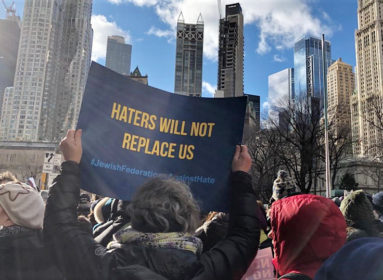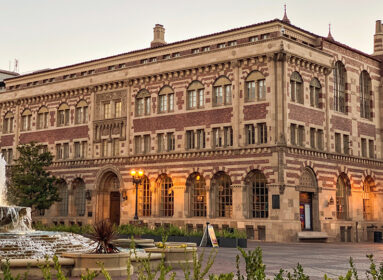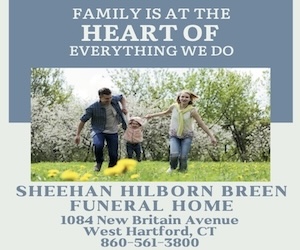By Cindy Mindell ~
WESTPORT — Steffi Friedman was 11 in 1936 when Nazi laws began to affect Jewish life in her native Berlin. That year, Friedman and her fellow Jewish classmates were transferred to the Wilsnacker Street School, a private institution funded by the Berlin Jewish community. The teachers were Jewish professors who had been dismissed from the universities. Two years later, she and her family fled the country, when Friedman was nearly 14.
Friedman went on to become an artist and educator, eventually settling in Westport and gaining international recognition as a sculptor. Eight years ago, she created “Never Again,” a bronze bas-relief sculpture for Temple Israel in Westport. In March, a model of the work was installed at the rededication ceremony of a synagogue in Niederzissen, Germany.
The model began its most recent journey from San Diego, home of Friedman’s son, Lawrence, who is friends with attorney Harvey Berger. During the Holocaust, Berger’s father and aunt were the only survivors of the 200 Jews who lived in Niederzissen, a town of 1,200 inhabitants located between Bonn and Koblenz. The Jewish population may have dated back to the Middle Ages, when a rabbi is purported to have arrived to establish a congregation.
“My parents were so freaked about the war that they didn’t deal with non-Jews very well, especially German non-Jews,” says Berger. So it was something of a surprise when they received a letter in the ‘70s, from Brunhilde Sturmer, telling them that she was trying to gather information about the lost Jewish community of Niederzissen.
Sturmer and her husband, Peter, are lifelong residents of the town. “This woman is not Jewish and for whatever reason, her life’s passion is to track and archive those Jewish families,” says Berger. His parents trusted her and sent her photos and information. In 1983, Berger’s father, Richard, died. His mother, Lore, diagnosed with cancer, was invited to Germany to receive reparations. Berger agreed to accompany her.
They met the Sturmers in Niederzissen and visited the autobody shop housed in the old synagogue, right next to the Bergers’ old home. After they left, Brunhilde kept the Bergers apprised of her progress: she cleaned up the stones in the Niederzissen Jewish cemetery and hired a translator to record the inscriptions on a chart that is now posted at the entrance. She visited libraries and archives in neighboring towns to gather more data. She climbed into the attic of the autobody shop and collected the artifacts she found there – prayer books, shofars, wimpels that had wrapped Torah scrolls – and stored them in a humidity-controlled room in her house.
In 2009, Berger took his daughter and her boyfriend to Niederzissen, where they stayed with the Sturmers. Brunhilde showed them the items from the old synagogue and told them that the owner of the autobody shop had died. A mayoral election was coming up and with it, a referendum on the fate of the building.

At the dedication: (l to r) Dr. Lawrence Friedman, Brunhilde Sturmer, Harvey Berger and Mayor Richard Kuler. Steffi Friedman’s sculpture is behind them on the wall.
“One candidate wanted to turn it into condos,” Berger says. “Brunhilde was pushing the incumbent to create a museum. He had worked in the building department of one of the nearby cities and was familiar with renovations. He won the election.”
The Niederzissen municipality received a 330,000-Euro cultural heritage grant from European governments to refurbish the building and an adjacent mikvah; during the restoration, the work crew discovered a long-hidden water well that once served the town.
“When I heard about what the town was doing, I thought it would be a perfect place for my mother’s sculpture,” says Lawrence Friedman. The synagogue building was rededicated in March. Steffi Friedman’s sculpture was installed where the Torah scroll used to be kept. The ceremony was standing-room-only, with speakers set up outside the building and a luncheon for more than 250 people.
Another room of the synagogue is a photo gallery of the Jewish families who once lived in the town. “I started crying when I saw that 90 percent of the photos were of my family,” Berger says.








 Southern New England Jewish Ledger
Southern New England Jewish Ledger











